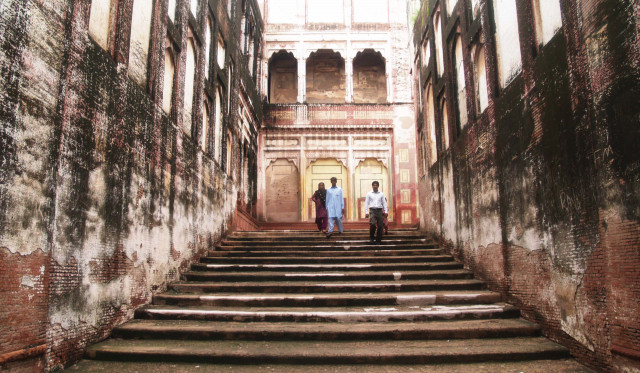
The marble in the walls of Diwane Khaas, Shah Jehan’s special audience hall in the Lahore Fort, feels like sandpaper. The edifice of the 17th Century building has faded from white to gray and yellow.
Similarly, the surfaces of the arches and pillars of Moti Masjid (Pearl Mosque) and the marble flooring and lattice work in Sheesh Mahal and Naulakha pavilion have deteriorated.
But the most visible effects of the pollutants attacking the city’s most valuable and celebrated piece of architecture is on the walls. The fort’s earthen northern boundary wall is speckled with carbon dust. The walls of the Maktib Khana, where all the royal correspondence was handled, have large black patches.
“The walls were cleaned with chemicals in 2004,” says Afzal Khan, who is deputy director of the Archaeology Department. “We left a few patches untouched to see the effects of pollution over the years. They are now charcoal black.”
Just half a kilometre from the Fort is the Badami Bagh bus terminal, the busiest in the city. Within a two kilometre radius are dozens of steel re-rolling units and small plants that use tyres as fuel. This part of Lahore has the dirtiest air in the city, said an Environment Protection Department inspector.
An estimated 4,500 buses and 3,000 cargo trucks, many fuelled by dirty diesel, pass through Badami Bagh every day, according to Muhammad Khalid, president of the Bus Owners Association.
A conservation expert working at the Fort for over 20 years says almost no building has escaped damage, but the white marble in Sheesh Mahal, Diwane Khaas, Diwane Aam, Pearl Mosque and the northern wall of the Fort are the most affected.
Different types of pollutants have different effects. Carbon settled on surfaces, apart from discolouring the walls, becomes acid with rain or humidity and erodes marble. Pollutants like sulphur and nitrates also cause acid rain.
The expert said that they treated the marble with cleaning chemicals. The carbon dust is scraped off and a new hydraulic mortar layer applied for visual improvement. “The high pollution levels mean twice the conservation effort is required,” he said.
“It is unfortunate ... people don’t seem to care about our historical sites. The Indians have done a great job of preserving Taj Mahal by restricting the movement of vehicles in its surroundings. Our government should do the same,” he said.
Saleemul Haq, the director of the Archaeology Department, said that the department had suggested in the 2006-11 ‘master plan’ for the Fort that a 500-metre special traffic zone be set up around the site.
“Only residents living in a 500-metre radius of the Lahore Fort would be allowed to drive vehicles in the zone. Also, electric or solar-powered vehicles would be introduced to pick and drop visitors to the Fort,” said Haq.
This would be hard to enforce. Plans to shift the Badami Bagh bus terminal have been around since the late 1980s, but transport companies have consistently resisted relocation. The Lahore High Court is currently hearing a petition from a transporter against the plan to relocate the bus companies to new terminals in Kala Shah Kaku and Thokar Niaz Beg.
Akram Khan, who owns five cargo trucks operating from the terminal, said the move did not make financial sense for him.
“It costs about Rs300 to send one carton of goods to Shah Almi or Akbari Mandi. The cost will go up by at least Rs500 if we relocate to Thokar or Kala Shah Kaku,” he said.
Khalid, the president of the Bus Owners Association, said that shifting the terminal would hurt bus passengers, who were mostly poor people. “No one thinks about the convenience of passengers,” he said.
He said that cargo truck companies had been offered plots to relocate to, but not the bus owners. He said the damage done to the Fort by pollution was “not my responsibility”.
Lorry Adda administrator Arshad Bhatti said traffic congestion was a more pressing concern. “I can understand the traffic issue but shifting because of a historical site? That sounds like something that would happen in a developed country. It’s not possible here,” he said.
Published in The Express Tribune, October 2nd, 2011.


















COMMENTS
Comments are moderated and generally will be posted if they are on-topic and not abusive.
For more information, please see our Comments FAQ